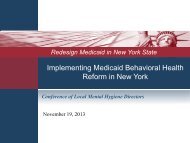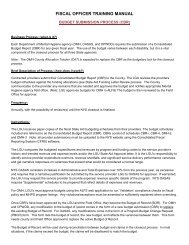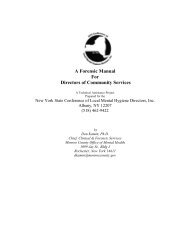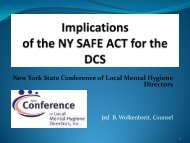fiscal officers training manual - New York State Conference of Local ...
fiscal officers training manual - New York State Conference of Local ...
fiscal officers training manual - New York State Conference of Local ...
Create successful ePaper yourself
Turn your PDF publications into a flip-book with our unique Google optimized e-Paper software.
FISCAL OFFICER TRAINING MANUALCASE MANAGEMENT FISCAL MODELSAssertive Community Treatment (ACT)Intensive Case Management (ICM) Supportive Case Management (SCM)Blended Case Management (BCM) Adult Home Case Management (AHCM)Residential Treatment Facility Transition Coordinators (RTFT)Business Process:The various Mental Health Case Management Programs, Assertive Community Treatment (ACT), Intensive CaseManagement (ICM), Supportive Case Management (SCM), Blended Case Management (BCM), Adult Home CaseManagement (AHCM) and Residential Treatment Facility Transition Coordinators (RTFT) are classified as “Modeled”programs with an established Gross Manager Cost, Medicaid Revenue expectancy and Net Deficit** (<strong>State</strong> Aid) funding.(Note: ACT and AHSCM programs serve only adults, while RTFT programs serve children and youth. ICM, SCM andBCM programs serve adults or children & youth) Each Case Management Program has a caseload or slot expectancy permanager or team. Service dollars for modeled case management programs are allocated per manager or team. (SeeCase Management Service Dollar procedures).Brief Description <strong>of</strong> Process:The Case Management Fiscal Models are posted in the Spending Plan Guidelines by local <strong>fiscal</strong> year and region(Upstate/Downstate and <strong>New</strong> <strong>York</strong> City). County-specific <strong>fiscal</strong> models are attached to the <strong>State</strong> Aid Letter in the CaseManagement Report Chart. County-specific models are derived by multiplying the applicable Case Management Model bythe approved Manager FTE’s. Changes affecting the approved manager FTE’s, such as the addition or closure <strong>of</strong> anICM/SCM position or designation as a BCM team, must be authorized by the Field Office prior to implementation.Modeled Manager Costs (ICM, SCM, AHSCM, BCM)ICM and SCM Gross Expenditures are identical with revenue expectancies calculated at a different rate. Currently, theICM Medicaid revenue expectancy is 90% <strong>of</strong> the Gross Manager Costs, and the SCM Medicaid revenue expectancy is68% <strong>of</strong> the Gross Manager Costs. The remaining manager expenditures are covered by Net Deficit** funding. The AdultHome SCM model is based on a team <strong>of</strong> one SCM and one half-time (.5 FTE) Peer Specialist. The program is fundedbased on a Medicaid revenue expectancy <strong>of</strong> 100% <strong>of</strong> the Gross SCM Cost and a 100% net deficit funded half-time Peer.Blended Case Management (BCM) is a team <strong>of</strong> one <strong>of</strong> the following three configurations - 1 ICM and 1 SCM, 2 ICM and 1SCM, 1 ICM and 2 SCM, or multiples <strong>of</strong> one <strong>of</strong> these combinations. The BCM <strong>fiscal</strong> model is determined by the mix <strong>of</strong>ICMs and SCMs on the team. The ACT <strong>fiscal</strong> model is based on either a 68 capacity team or a 48 capacity team. TheMedicaid revenue expectancy is currently 92% <strong>of</strong> the Gross team operating cost. The remaining operating and <strong>training</strong>costs for the ACT team are net deficit funded**. A portion <strong>of</strong> the funding for ACT <strong>training</strong> is retained by the OMH.Modeled Service Dollar CostsIncluded in the model costs are service dollar amounts per manager or team. Service dollars are net deficit funded** andare budgeted as a distinct program from the Manager program. For the ICM and ACT programs only: an ICM or ACTteam may be funded “locally”, through the County’s <strong>State</strong> Aid Funding Letter, or may be considered “<strong>State</strong> Operated”.Counties receive only Service Dollar funding for “<strong>State</strong> Operated” ICMs or ACT teams; the Manager cost is assumed bythe <strong>State</strong>. Refer to the Case Management Service Dollars Procedure for additional details on service dollars.**Net Deficit Funding: In some counties Net Deficit funding may be a combination <strong>of</strong> <strong>State</strong> Aid and DSH revenue.Counties should refer to the county-specific Case Management Report to determine the DSH amounts to be budgeted ifapplicable.Frequency:Case Management Fiscal Models are posted for each local <strong>fiscal</strong> year and may be adjusted yearly. Providers budget theirCase Management programs annually to match their model.Instructions:BudgetsProviders should be instructed to complete their budgets (CBR) per the associated Case Management Model pertaining tothe number <strong>of</strong> managers, program and year. Provider's budgeted Gross Costs, Income (Medicaid) and Net Deficit








